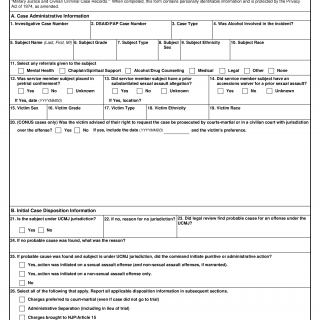DD Form 3114. Department of Defense Uniform Command Disposition Report
DD Form 3114, the "Department of Defense Uniform Command Disposition Report," is a document used by the United States Department of Defense (DoD) to gather comprehensive information and report the final disposition of cases involving sexual assault allegations. This form contains sensitive and personally identifiable information, is subject to the Privacy Act of 1974, and plays a crucial role in documenting and managing cases of sexual assault within the military.
Purpose:
The primary purpose of DD Form 3114 is to provide a standardized means for reporting the final disposition of cases related to sexual assault, particularly those involving members of the Armed Forces. The form gathers information on the investigation, legal proceedings, and administrative actions taken regarding each case. It ensures compliance with the Privacy Act and helps maintain a record of how such cases are handled.
Usage Case:
DD Form 3114 is used in the following context:
- Reporting Sexual Assault Disposition: This form is employed when the alleged offender is a member of the Armed Forces and the adult victim has filed an unrestricted report of alleged sexual assault. The form is used to document the entire process, from investigation to legal proceedings, administrative actions, and any civilian authority involvement.
Structure:
DD Form 3114 consists of several sections, each designed to collect specific information related to the sexual assault case and its disposition. The main sections include:
Section A: Case Administrative Information: This section gathers essential details about the case, including investigative case numbers, subject and victim information, and any referrals made.
Section B: Initial Case Disposition Information: This section records information on the subject's legal jurisdiction, whether legal review found probable cause, and whether punitive or administrative action was initiated.
Section C: Court-Martial Information: This section is focused on the court-martial process, listing any sexual assault charges preferred, non-sexual assault charges preferred, details about the Article 32 hearing, and court-martial outcomes.
Section D: Non-Judicial Punishment Information: Records information on whether non-judicial punishment (NJP) was imposed and provides details on the charges and the results of NJP.
Section E: Administrative Separation: Gathers information about whether the subject was processed for administrative separation and, if so, the reasons, board decisions, and the characterization of service upon separation.
Section F: Other Adverse Administrative Action: This section addresses any other adverse administrative actions taken against the subject, such as counseling, admonishment, or other disciplinary measures.
Section G: Civilian Authority Action: Documents any actions taken by civilian authorities regarding the case, including investigation, prosecution, jurisdiction, charges, and outcomes.
Section H: Case Synopsis Information: Allows for a concise summary of the case, including unique circumstances and actions taken due to civilian prosecution, separation unrelated to the assault, and consultation with legal advisors.
Section I: Reporting Command Information: Provides contact information for key personnel involved in the reporting process, including the command point of contact and judge advocate consulted.
The form is accompanied by specific instructions for filling out each section, ensuring uniform reporting across cases of sexual assault in the military. It is an essential tool for documenting, reviewing, and managing cases to ensure compliance with the law and maintain records of the disposition of each case.

